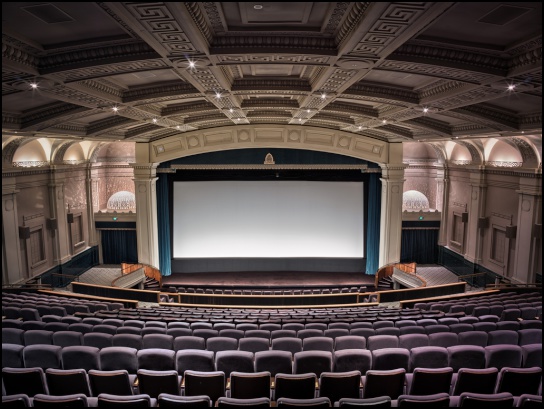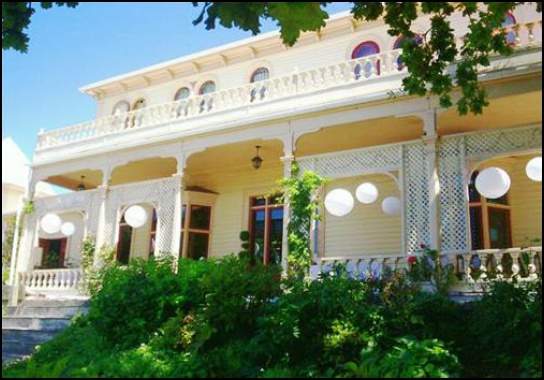Houses and Halls
Howard
DavisNew Zealand is renowned for the natural beauty of its countryside, but three events I was fortunate to attend last weekend underscored that its built environment also deserves to be treasured.
Opened in 1924 and harking back to the era of grand movie palaces with exotic names like the Rialto, Odeon, and Alhambra, the Embassy Theatre is a refined example of Wellington's rich architectural heritage. Designed by Llewelyn Williams, it's exterior is stripped classical, the interior classic Greek Revival hardtop. Originally seating 1,749, various remodels during the 1960s included the installation of a proscenium arch and false ceilings, which reduced seating capacity to 852. Further alterations were underwritten by a $4.5 million grant provided by the City Council for the world premiere of 'The Lord of the Rings: The Return of the King,' which revealed original paintings that had been hidden behind the false ceiling installed in 1965. In addition to earthquake strengthening, these renovations included refurbishing the interior to restore many elements of Williams' original design.
It's always a pleasure just to enter the magnificent lobby, which has retained its mosaic floors, Sicilian white marble staircase, blue-tiled walls, dark wooden fixtures, and bronze fittings. The original screen and proscenium have been preserved behind the 70mm screen installed in 1965 - one of the largest in the Southern Hemisphere. The furnishings complement a sense of classical style that even penetrates the restrooms, which mirror the tiling and match the wooden fixtures found elsewhere in the theatre.

Interior of the Embassy Theatre
Unfortunately, 'Spectre,' the latest edition of the Bond franchise, didn't really do justice to its opulent surroundings. Stunning scenery, extraordinary aerial cinematography, and pulsating chase sequences don't do enough to compensate for Daniel Craig's leaden performance. In spite of exotic locations like Mexico City, London, Rome, Austria, and Morocco, the movie lacks local colour, flavour, and garnish. While we can expect Blofeld's desert lair to be brutally modern, full of grim grey steel and flat chrome surfaces, there's a telling moment when Moneypenny surveys Bond's sparsely decorated Knightsbridge apartment and asks whether he's just moved in. The film displays plenty of chilling architecture, frozen landscapes, and high-tech gadgetry, but has too many gaping pot-holes in the plot-line, too little humour, and lacks any real warmth or glamour (despite Lea Seydoux' Gallic chic). Only the spectacular Day of the Dead opening sequence suggests the sinister suspicion that appearances may not always be what they seem.
* * *
After the movie, I attended the Scoop party at Dransfield House, listed as a Class II "Historic Place." Built around 1875, it's one of only four substantial houses in Wellington that remain from this period. Wellington's first Mayor, Joe Dransfield bought the house from his brother in 1885. In 1896, it was sold to the wife of Councillor Eberhard Focke, who added an octagonal bay as a conservatory and the turret known as the 'Spire Lounge Bar.' In 1905, the property was purchased by Alfred Kernot, JP and Consul for Paraguay, who built extensive stables and a coach house on the area now covered by the lower gardens. In 1923, Dr. David Lloyd Clay bought the house and used it as his surgery. Clay died in 1935, when ownership was transferred first to the Public Trust, then to the City Council in 1938. Around 1940, Ethel Jane Wickens leased the property as her personal residence. Her daughter and grand-daughter held the lease until the late 1970's, when the house was briefly divided into individual apartments and the main downstairs 'Ballroom' converted into a restaurant.
During the 1980s the property was run as an Arts Centre, then left vacant until 1995 when it was torched by vagrants and the upper floors disfigured. Fortunately, the ground floor only suffered minor smoke damage. In 1995, prominent lawyer and vintage American car aficionado Kevin Smith personally undertook the extensive and painstaking restoration work. He relocated his law practice to the upper floor and opened the downstairs as a bar and restaurant, utilising partially vitiated floorboards as dining tables.
Nestled behind three 110 year-old English oak trees on its Willis St. frontage, Dransfield House features a "hip and valley" roof profile, with a symmetrical street elevation that's focused on a central gable decorated with a finial above a pair of round headed windows. Built in the Italianate style, finely filigreed fretwork adorns the exterior veranda and balcony, while splendid examples of rim, kauri, and matai joinery embellish the interior. A delightful stained glass window depicting tui birds once decorated the first floor landing and the windows surrounding the entrance were lead light glass. Sadly, only two small panels above the main entrance have survived.
 Dransfield House
Exterior
Dransfield House
ExteriorDransfield House is a superb example of the kind of substantial wooden houses that were constructed in Wellington and throughout New Zealand between 1870 and 1910. Specimens of such compelling craftsmanship are increasingly rare, especially in urban areas, and it's an important reminder of the need to preserve such elegant residences.
* * *
Ahiaruhe House, the home of Simon Burt and Pip Steele, is another fine example of late-Victorian architecture located near Aotea Stonehenge. It not only enjoys stunning 360 degree views of the Wairarapa, but also some first-rate decorative features and original interiors. Simon tired of attending public performances where oafish members of the audience talked loudly and generally ignored the performer they had ostensibly turned up to see. He avoids that problem by issuing invitations to visiting musicians and a small, but appreciative audience of acoustic music lovers.
 Hopetoun
Brown
Hopetoun
BrownAll profits go to the performers and last weekend was the turn of Hopetoun Brown, a ridiculously talented pair of horn players whose highly-syncopated honking riffs on trumpet, trombone, and saxophone are accompanied by a variety of foot-stomping percussive energy. Welded to their shrieking horns since they were kids, Tim Stewart and Nick Atkinson'shave hot-forged tunes from their fiery friendship ever since. Bent across the anvil of funk that is Supergroove, they blast out ferocious gut-bucket, high-octane, rocket-fueled blues. You can get a taste from their debut album 'Burning Fuse.' Better still, catch them live for a full-course feast of their steaming hot, house party sound.



 Binoy Kampmark: Fallibility, Dirty Wars And Pope Francis I
Binoy Kampmark: Fallibility, Dirty Wars And Pope Francis I Peter Dunne: Dunne's Weekly - An Issue No-one Can Afford To Lose
Peter Dunne: Dunne's Weekly - An Issue No-one Can Afford To Lose Martin LeFevre - Meditations: Choosing Mass Murder?
Martin LeFevre - Meditations: Choosing Mass Murder? Eugene Doyle: Quiet Mutiny - The U.S. Army Falls Apart
Eugene Doyle: Quiet Mutiny - The U.S. Army Falls Apart Gordon Campbell: Papal Picks, And India As A Defence Ally
Gordon Campbell: Papal Picks, And India As A Defence Ally Binoy Kampmark: The Selling Of America - Ending The US Dollar’s Exorbitant Privilege
Binoy Kampmark: The Selling Of America - Ending The US Dollar’s Exorbitant Privilege